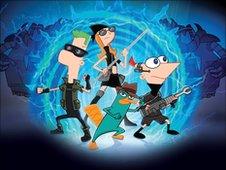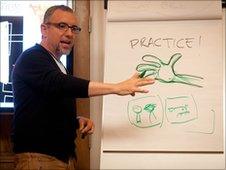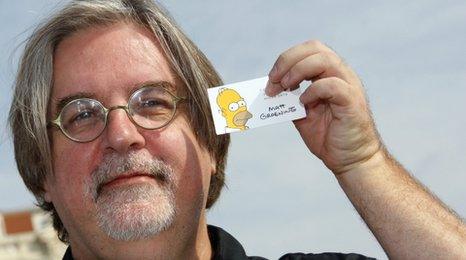Phineas & Ferb Disney animators share their career tips
- Published

Dan Povenmire and Jeff "Swampy" Marsh are the brains behind the Disney cartoon Phineas and Ferb.
The two Emmy award-winning Disney animators met when they worked on The Simpsons.
Dan was previously known for his work on Rocko's Modern Life and Family Guy while Swampy had credits on King of The Hill and even Postman Pat.
We got their guide on what it takes to be an award-wining animator.
Core skill: Drawing is your craft
"For every second that you see on-screen there's 24 frames which in essence is 24 drawings," says Dan.
He'll sketch around 300 to 400 pages of artwork for each episode produced.

Dan and Swampy got into the industry when animators sketched all their artwork on paper.
Swampy says that's changing.
"Paper is being taken out of the equation. Most of our guys are drawing with a stylus directly on the screen."
Other essential skills include storytelling, a good sense of timing and composition and an understanding of motion, size, ratios and perspective.
Keeping ahead: Technical ability is a must
PCs are crucial tools in cartoon production as Dan explains: "We still draw by hand but instead of filming it with a camera and developing the film, we scan it into a computer.
"All the camera work, all the colouring is done on a computer.
"A lot of movies like How To Train Your Dragon and The Incredibles - that sort of CG movie - an even larger portion is done on computer. "
How to get noticed: Build up a portfolio of work
Swampy's portfolio came about thanks to a friend recognising his talent and a background in architecture giving him a sense of perspective.
"I had a friend who said you draw really well," he said.
"He helped me get a portfolio together and within about three months later I had a job on The Simpsons. I got lucky."
Dan started out by writing and drawing a daily cartoon strip called Life is a Fish at university.
"I did caricatures for a living, almost all of my jobs have been art-related since I was young. And then I did animated segments for feature films.
"I worked with Adam Sandler and then I took a job on Teenage Mutant Hero Turtles and then The Simpsons."
Everyday tasks: Teamwork and multitasking is a given
Whether traditional hand drawn, model or computer (CGI) animation there are common tasks animators do on a day-to-day as Dan explains have to write the show, design the characters, props and backgrounds that go into the show.
"We paint them all, colour them, storyboard them all, time them because every single frame needs to be accounted for by a timer. Every blink has to be pre-planned."
And it all takes time says Swampy.
"Ten months is really a breakneck schedule for us," he said.
Secret to a successful animated show

In the US Phineas and Ferb: Across the 2nd Dimension is the most watched cable TV movie of 2011 so far with 7.6m viewers.
So what's their secret? Dan says it's simple: "Continue to make it funny."
Swampy adds: "We have great imaginations but still we could not have imagined that [Phineas and Ferb] would be this huge."
Top tip for aspiring animators
Dan's advice is : "Always work at getting better and better at it. And know that you can make a living drawing pictures.

"A lot of adults will tell kids there's a reason that they call them starving artists - it's because they're starving. That's just not the case."
Swampy says: "If you're doing something that you love, however much money you're making, it will always be enough.
"If you're doing something you don't love, no matter how much money you're making, it will never be enough."
- Published5 August 2011

- Published5 October 2010

- Published13 October 2009
